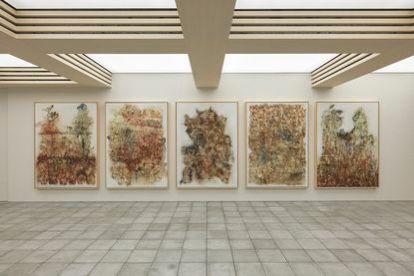Artists, like fashion designers, do not create in a vacuum. Mirroring their philosophical, sociopolitical, and spiritual connections to their home countries, African artists have long reshaped the fashion industry through wearable art.
Wearable art is a dynamic and interactive art form. Between African visual art and slow fashion, wearable art is pushing the boundaries of traditional design, redefining the concept of luxury and style, and paving the way for a creative revolution on a local and global scale.
Courtesy of The New York Times/Victoria and Albert Museum, London
Dennis Osadebe for Hermes, Zandile Tshabalala for Schiaparelli and Iris van Herpen, and Jamilla Okubo for Dior: These are just a few of the many African artists that have expressed themselves esthetically and making artistic statements as they collaborate with top fashion brands in recent years.
Wearable art can be in different forms. It could be in the form of clothing from WUMAN, a contemporary African fashion-art brand by Nigerian fashion artist Ekwerike Chukwuma, The Ikiré Jones Collections from Walé Oyéjidé which have been seen in the “Black Panther” and “Coming 2 America” films; or accessories like Cyprus Kabiru with his sculpted eye masks, Kehinde Wiley’s collection of printed scarves, Yinka Ilori’s tote bags in collaboration with Marks & Spencer.

Wearable art is often inspired by the artist’s goal to create. The creations are the result of experimentation with various dimensions and handmade techniques, and they are not constrained by market demands or trends. It is usually handcrafted and produced in very limited series. It is often made from new or repurposed textile materials, leather, fibers, beads, and even metal or plastic. By sculpting, dyeing, crocheting, felting, collage, gluing, painting, weaving, knitting, or piecing, the materials can be manipulated and shaped.
Like Kenyan multidisciplinary artist Cyrus Kabiru is sculpting artistic eyewear from found objects; Nike Davies-Okundaye is designing differently-hued fabrics with intricate patterns using a wax-resist technique called batik. Nigerian fashion artist Ekwerike Chukwuma tells stories with his garments, exploring human anatomy and architecture with his brand, WUMAN. Kehinde Wiley’s limited-edition collections, like scarves and tote bags, feature a selection of the artist’s favorite compositions from his archive.
It is important to know that not all wearable art is for everyday wear, however, they can be exhibited, modeled, or used in performance.
Courtesy of Colors x Studios
African fashion has always focused on sustainability, from Nigeria’s Asooke and Adire to Congo’s Kuba Cloth, South Africa’s Ndebele, Xhosa, and Shweshwe fabrics, Malians’ Mud cloth, Ghana’s Kente Cloth, and Tanzania, Kenya, and Uganda’s Kanga and Bark Cloth, which were mostly produced using eco-friendly dyes and weaving methods. This is due to their longstanding tradition of utilizing natural fibers like cotton, silk, and raffia in traditional materials and textiles creation.

Courtesy of the brand.

Courtesy of The New York Times
African visual artists and fashion designers are working together more frequently, and this is a trend that has come to stay. It is an excellent opportunity for fashion brands to initiate cross-cultural dialogues that deepen awareness of African art while also being inclusive in their designs in order to reach a new market audience. It allows African artists to experiment with various mediums, which stimulates artistic innovation and broadens their audience. With limited collections of wearable art, an artist’s uniqueness and appeal among collectors and fashion enthusiasts becomes noticeable.
These collaborations, in the end, provide a space where culture, creativity, and commerce interact, reimagining fashion as a canvas for artistic expression and cross-cultural communication.
Iyanuoluwa Adenle is a Nigerian art writer, essayist, and poet based in Lagos. She is currently the head writer at Omenai. Adenle has contributed to a number of art publications, including Tender Photo, Art News Africa, Pavillon 54, and Omenai.






